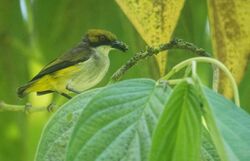Biology:Olive-capped flowerpecker
| Olive-capped flowerpecker | |
|---|---|

| |
| Nominate subspecies seen in South Cotobato. | |
| Scientific classification | |
| Domain: | Eukaryota |
| Kingdom: | Animalia |
| Phylum: | Chordata |
| Class: | Aves |
| Order: | Passeriformes |
| Family: | Dicaeidae |
| Genus: | Dicaeum |
| Species: | D. nigrilore
|
| Binomial name | |
| Dicaeum nigrilore Hartert, 1904
| |
The olive-capped flowerpecker (Dicaeum nigrilore) is a species of bird in the family Dicaeidae. It is endemic to the island of Mindanao in the Philippines .Its natural habitat is tropical moist montane forest.
Description and taxonomy
EBird describes the bird as "A small, rather long-billed bird of montane forest on Mindanao. Olive-green on the back, darker on the edge of the wing, with a golden-olive head, a pale gray throat separated from the head color by a black line, a pale gray chest, and pale yellow on the sides and under the base of the tail. Note the black legs and the red eye. Somewhat similar to olive-backed flowerpecker, but has a longer bill and a yellowish lower belly. Voice includes a high-pitched upslurred whistle and a rough 'jiik!'"[2] Often seen feeding on fruiting and flowering trees.
Subspecies
Two subspecies are recognized.
- Dicaeum nigrilore nigrilore found in West, Central and Southern Mindanao has a more visible yellow rump
- Dicaeum nigrilore diuatae found in Northeast Mindanao has an overall darker green and drabber color and a greenish yellow rump.
A possible third subspecies which has a yellowish-green head is found in Southeast Mindanao. Further study is needed on this potential subspecies.[3]
Habitat and conservation status
It inhabits tropic moist sub-montane and montane forest above 900 masl.
IUCN has assessed this bird as a least-concern species. Despite a limited range, it is said to be locally common in its range. As it occurs in rugged and inaccessible mountains, this has allowed a large portion of its habitat to remain intact. However, there it is still affected by habitat loss through deforestation, mining, land conversion and slash-and-burn - just not to the same extent as lowland forest. [4]
References
- ↑ BirdLife International (2016). "Dicaeum nigrilore". IUCN Red List of Threatened Species 2016: e.T22717497A94535614. doi:10.2305/IUCN.UK.2016-3.RLTS.T22717497A94535614.en. https://www.iucnredlist.org/species/22717497/94535614. Retrieved 11 November 2021.
- ↑ "Olive-capped Flowerpecker". https://ebird.org/species/olcflo1/.
- ↑ Allen, Desmond (2020). Birds of the Philippines. Barcelona: Lynx and Birdlife International Field Guides. pp. 348–349.
- ↑ International), BirdLife International (BirdLife (2016-10-01). "IUCN Red List of Threatened Species: Dicaeum nigrilore". https://www.iucnredlist.org/en.
Wikidata ☰ Q339470 entry
 |


